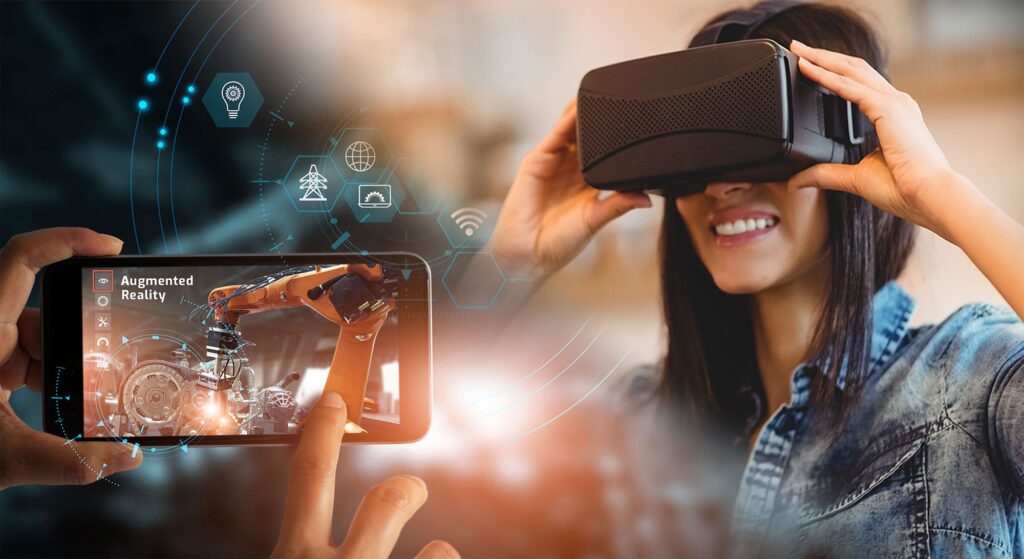
If you’ve been keeping up with the latest technology trends (or our most recent Upreal Digital blog posts!), you may have heard two new buzzwords floating around: Augmented Reality (AR) and Virtual Reality (VR).
Though the terms “virtual reality” (VR) and “augmented reality” (AR) are often used interchangeably…
…they refer to very different concepts with easily identifiable characteristics!
The distinction between them can be blurry, especially to the uninitiated.
And as the two technologies develop, they may even see some signs of overlap in their functionality.
But for now, Augmented Reality and Virtual Reality remain two distinct platforms with various use cases specific to them.
We’ve touched on both terms in past writings, but now? We want to dive deeper.
So what exactly ARE these new technologies? And what’s the difference between Augmented Reality and Virtual Reality?
This article will explore the basics of both Augmented Reality and Virtual Reality to help you get a better grasp of their unique aspects.
In addition, we’ll go over many of their particular characteristics, strengths, and points of opportunity.
Lastly, we’ll also take the time to look at specific applications of each one and how you might best apply them for your own projects!
If you’ve been waiting to learn more about these exciting, emergent technologies… then look no further!
Read ahead with Upreal Digital and get caught up to speed.
Augmented Reality (AR)
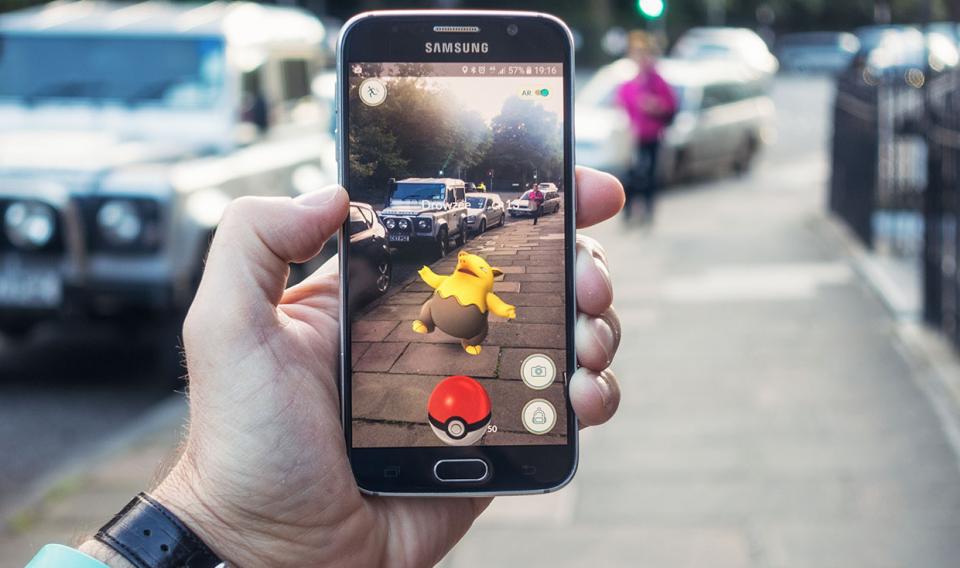
Augmented Reality, or AR, can best be described as an enhanced vision of reality created by overlaying digital information or assets on top of a static image or video of the real world.
These elements and data points are then viewed through a device (typically a smartphone or tablet) to make them interactive with an audience.
The triggers to view AR assets can be embedded in mobile apps, built into features like camera filters and web browsers, or scanned off of physical and digital markers, such as QR codes.
This makes them highly portable and can be accessed through various portals regardless of the user’s location.
Augmented reality’s leading utility is adding digital layers of information on top of the physical world around us.
Such digitally-implanted resources can provide additional data about the physical world around us…
…or create entirely new environments and objects that don’t exist in the real world and insert them into our usual fields of perception.
While AR technology is still in its early stages, it has already been used in several applications, such as gaming, education, and navigation.
One such famous example is the mobile game Pokemon GO!
In it, characters and creatures from the Pokemon anime and game series are implanted into everyday scenes captured by your phone’s camera.
This creates the illusion that the Pokemon are actually there…
…opening up a new level of immersion for the players in the AR experience!
Other well-known examples include:
IKEA Place. An app that lets users place virtual furniture and decor in their homes before they buy it.
Amazon AR View. An app that allows users to view and demo Amazon products before finalizing a purchase.
Toyota’s Immersive AR app. A service that allows users to digitally tour and browse Toyota-brand vehicles after scanning web-based media, such as banner ads.
Virtual Reality (VR)
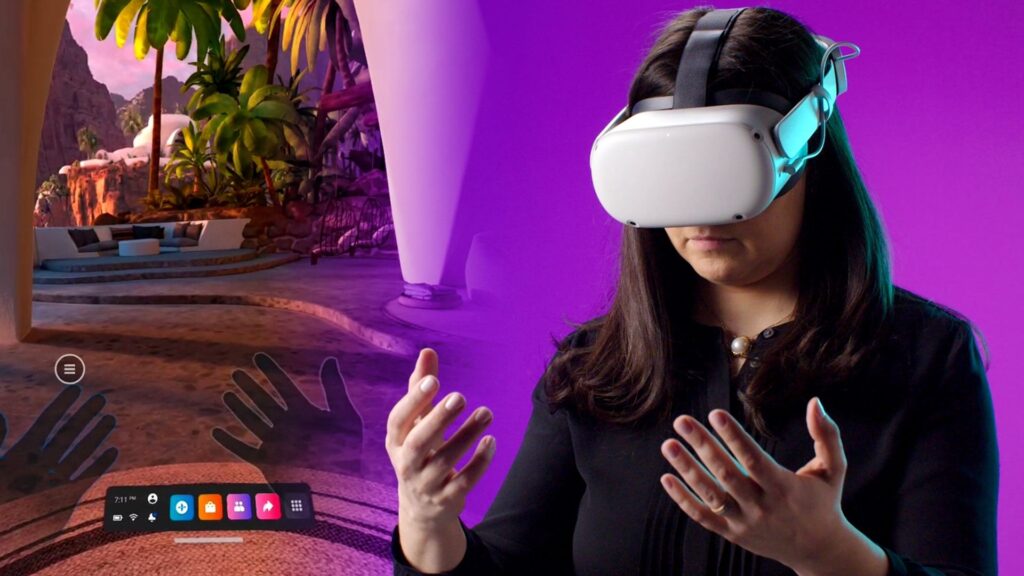
Virtual Reality, or VR, is an artificially created world that makes users feel like they are experiencing it firsthand.
It creates a three-dimensional environment for them to explore and interact using their senses, similar to how they would in real life.
VR spaces are made with a combination of dedicated computer hardware and software.
Typically, users will wear external devices like helmets or goggles to feel as if they’re inside and can control these generated scenes.
These devices are usually bound to a central location, like a high-powered computer, to supply the power and output to run the VR experience efficiently and effectively.
There are three main types of VR systems, which differ based on their function and the technology they rely upon:
Non-immersive. Also known as desktop VR, it is a type of virtual reality that simulates a three-dimensional environment. It emanates from a 2-Dimensional interface, such as a flat screen. The user has limited control over the virtual environment, but not so much that they physically interact with it. This variant of VR is best-suited for experiences that are tailored to devices like mobile phones or desktops.
A computer-based video game or an interior design website are examples of non-immersive VR experiences.
Semi-immersive. This variant of VR only offers a partial virtual experience accessed from electronic devices such as computers, glasses, or headsets. It offers a range of movement known as 3DOF, or “three degrees of freedom,” which aligns with the axes that a human’s body can move in three-dimensional space. This type of VR focuses more on the visual 3D side of Virtual Reality. It does not include total physical movement and engagement as full immersion does.
For example, flight simulators used by pilots in airlines and militaries are typical examples of semi-immersive VR.
Fully immersive. This trend of VR delivers a high level of virtual reality, granting the user the utmost engagement in the simulated 3D world. It encompasses sight, sound, and sometimes, even touch sensation. It utilizes a range of movement known as 6DOF, or “six degrees of freedom,” representing a higher number of axes of the human body while in VR.
The fully immersive experience is the type that requires tech such as helmets, goggles, or gloves to allow maximum interactivity with the environment.
There might also be the incorporation of fitness-style equipment like treadmills or bicycles to provide users with a lifelike sensation of movement through 3D space.
Gaming or social media outlets that are hosted on platforms like the Horizon Worlds Metaverse via the Oculus Rift are prime examples of this VR sub-type.
AR vs. VR: The Comparison
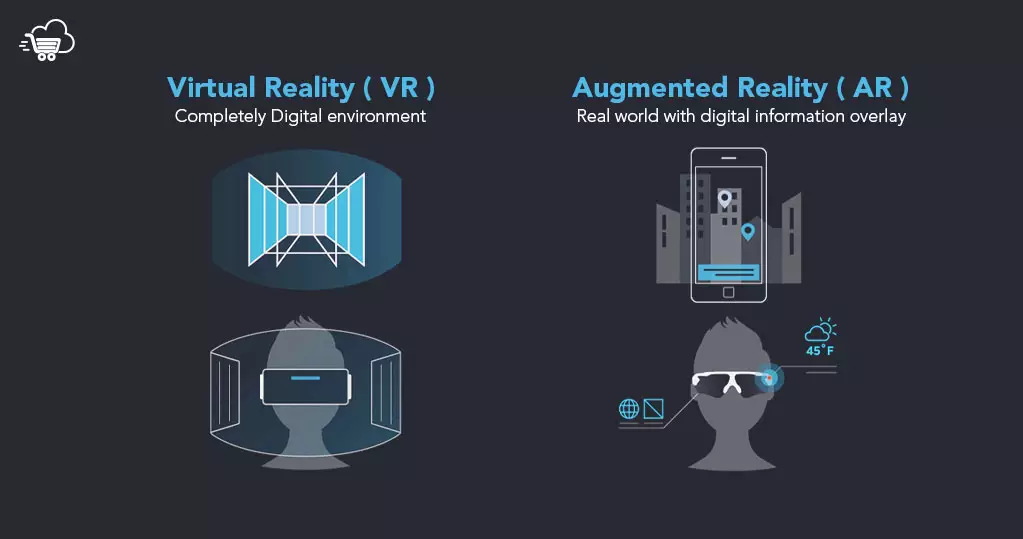
Now we’ll run through a side-by-side examination of augmented and virtual reality and the finer points that separate them.
AR and VR have various differentiating factors. Nevertheless, this does not indicate that either technology is superior to the other.
Instead, they excel in separate areas and may be better fitted for different use cases.
As we’ve discussed, Virtual Reality (VR) creates an entirely immersive virtual environment. In contrast, augmented Reality (AR) overlays digital information on top of the real world.
As such, VR is primarily virtual (roughly 75%), while AR is only partially so (25%).
To experience VR, users typically require equipment to support the experience. Namely, a dedicated computer and associated headset device or visor.
These peripherals are unnecessary for AR, as applications centered around its use can be viewed through most common consumer devices like smartphones or tablets.
In VR, users are fully transported into a realistic fictional world with little interference or borrowing from the physical world around them.
By contrast, in AR, they are still mainly in contact with the natural world, which is instead altered or amplified by digital enhancements.
All-in-all, AR’s main selling point is providing a delivery system for a fused experience of both the virtual and physical worlds.
VR supplants the need to draw from the physical world to realize its goal. Instead, It is designed to suspend the user’s disbelief with wholly artificial creations.
AR vs. VR: Advantages & Disadvantages

Now that we know how they differ, let’s highlight some of the strengths and weaknesses of both technologies…
…and what kind of projects may best benefit from them!
Advantages of Augmented Reality:
- Allowing users to see digital content in the context of the natural world can make it easier to understand and engage with.
- Augmented reality has a lower barrier to entry than virtual reality, as it can be experienced through more consumer-accessible devices.
- Augmented reality experiences can be less jarring and more comfortable for some people than virtual reality.
Disadvantages of Augmented Reality:
- Augmented reality experiences can be less immersive than virtual reality, as they do not entirely remove users from the physical world.
Common Use Cases (AR):
- Retail and Marketing. Consumers can now use store apps to see how products will look in their homes before purchasing, such as furniture. Advertising campaigns can be made more memorable and novel via AR elements and available anywhere your phone or web browser could be!
- Entertainment and gaming. AR can be used for several purposes in the recreation sector, like placing a virtual game in the real world or applying cosmetic filters to alter their appearance on social media posts.
- Navigation. AR technology can lay a route to the user’s destination on top of their live view of a road. AR navigation can also show nearby businesses and other helpful information.
- Tools and Measurement. AR on mobile devices allows users to measure 3D points in their environment or test home design choices like paint swatches and wallpaper.
Advantages of Virtual Reality:
- Virtual reality can create immersive experiences that transport users to other worlds.
- Virtual reality experiences can be more engaging and memorable than augmented reality or traditional media experiences.
- Virtual reality can be used for training and simulation purposes in various fields.
Disadvantages of Virtual Reality:
- Virtual reality experiences can be uncomfortable or even nauseating for some people.
- Virtual reality requires specially designed hardware like headsets, which can be expensive and inaccessible for some people.
- Virtual reality experiences are not as mobile as AR equivalents, as they are tethered to a computer rather than openly available.
Common Use Cases (VR):
- Entertainment. No longer confined to our screens, with VR, we can explore other worlds and exist within them. The technology has already made waves in the gaming industry on computers and consoles (namely with PSVR). It also holds promise for film and television.
- Training. Virtual reality provides a safe, efficient and affordable way to train personnel in high-risk occupations, such as firefighters, EMTs, police officers, soldiers, surgeons, or other medical staff.
- Education. With VR, educational institutions have an immersive way to teach and engage students. For example, by using VR, history teachers might show what it was like to live in ancient Rome or Japan.
- Real Estate & Tourism. Architects can use VR technology to give people a realistic and interactive 3D view of their proposed plans and even what potential remodels might look like before committing. There is also the potential for an entirely new industry surrounding virtual tourism – allowing people to experience amazing places without ever having to leave their homes!
AR vs. VR: The Conclusion
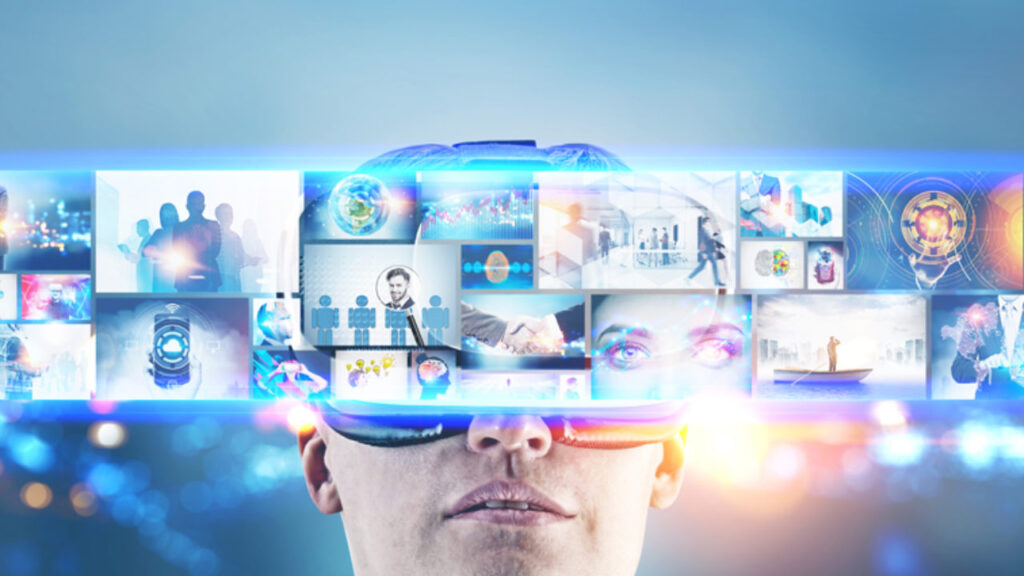
Augmented reality and virtual reality are two cutting-edge technologies with nearly limitless potential!
They both have their pros and cons in terms of applicability…
…there is no doubt that both are potent tools that can be put to great use with a little imagination!
The key to unlocking their power lies in determining which suits your project, design goals, and needs.
Suppose you’re looking for a top-down immersive experience that transports you to another world. In that case, virtual reality is the way to go.
However, if you go this route…
…remember that you are ultimately sacrificing a less adaptive way of entry for a platform that provides creative freedom. AR can’t quite offer the novelty that VR does.
Augmented reality is the better choice if you want a more mobile and flexible experience that allows you to interact with the real world.
If this is your case, bear in mind the smaller scale and how you plan to weave the digital into the natural world. You cannot rely on VR’s all-encompassing presentation!
No matter what you decide, one thing is for sure – these technologies are changing how we live, work and play.
We hope you feel better equipped to discuss and utilize these profound new technological advancements!
Stay connected with Upreal Digital for more on AR and VR. Until next time!
